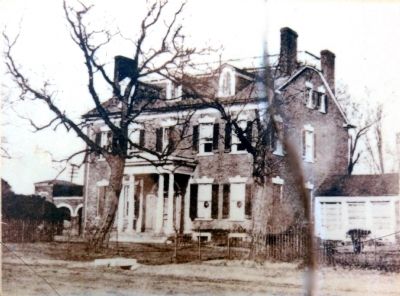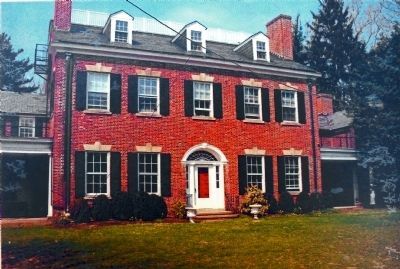Old Town West in Alexandria, Virginia — The American South (Mid-Atlantic)
Colross-Alexandria's Urban Phoenix
Alexandria Heritage Trail
For over a century, this two-acre block was occupied by a mansion known as Colross. Built in 1800 by John Potts, the mansion, with its outbuildings, gardens, orchard, and a "clover lot" was in effect a small plantation.
Colross's owners included some of Alexandria's most prominent citizens. Jonathan Swift -- merchant. diplomat, and lodge brother of George Washington -- occupied Colross until 1824. In the 1830s, Thomsen Mason (grandson of George Mason of Gunston Hall) stylishly renovated the property, which had been used as a military boarding school. Mason, who died in 1838, was buried in a brick vault behind the house, although the vault later was removed and the remains re-interred elsewhere. William Smoot, a merchant who bought the property in the 1870s, continued t maintain Colross as an elegant oasis at the edge of a rapidly growing city.
After World War I, Colross's fortunes declined, when new owners divided the property. They constructed a warehouse on the northern half of the block, and used theold mansion as a boarding house for workers at The Virginia Shipbuilding Corporation. In 1927, a tornado ripped through the western end of Alexandria; among the casualties was the once-proud home of the Swift, Mason and Smoot families.
When investigations at Colross began in 2004, the chances of finding any meaningful archeological evidence seemed remote. In 1929, an interested buyer had dismantled the mansion and rebuilt it in Princeton, New Jersey. Moreover, the block later was occupied by 20th century commercial buildings, including a car wash.
But like the legendary Phoenix, Colross had not altogether disappeared. As backhoes removed layers of modern rubble, details of the block's historic landscape slowly emerged, the complex foundations of the main house basement, the original kitchen for the house, enclosed herringbone brick floors, a well, floor drains, multiple rooms and four massive fireplace bases. West of the house, an area of brick paving defined a courtyard where stables once had stood, and the foundations of Mason's office wing emerged east of the main house. A large domed cistern, also added during the Mason period, provided the household's water supply for much of the 19th century. To the north, where gardens had once bloomed, lay the empty base of the Mason family burial vault. Even the brick piers that supported the early 20th century warehouse were intact.
The investigations undertaken at Colross demonstrated, once again, the power of archeology to document a seemingly irretrievable chapter of our past.
Erected by Diamond Properties LLC in cooperation with the Alexandria Archaeology Museum, Office of Historic Alexandria.
Topics and series. This historical marker is listed in these topic lists: Anthropology & Archaeology • Notable Buildings. In addition, it is included in the Virginia, The City of Alexandria series list. A significant historical year for this entry is 1800.
Location. 38° 48.647′ N, 77° 3.057′ W. Marker is in Alexandria, Virginia. It is in Old Town West. Marker can be reached from the intersection of Oronoco Street and North Fayette Street, on the right when traveling west. The marker is in the courtyard northeast of the intersection, which is in the Old Town West neighborhood of Alexandria. Touch for map. Marker is at or near this postal address: 1111 Oronoco Street, Alexandria VA 22314, United States of America. Touch for directions.
Other nearby markers. At least 8 other markers are within walking distance of this marker. War, Rails, and Wells (about 400 feet away, measured in a direct line); Alexandria and Fredericksburg Railroad (about 500 feet away); The Civil War & Archaeology of the Block (about 600 feet away); Ramsey Homes (approx. 0.2 miles away); Third Baptist Church (approx. 0.2 miles away); The First Parker-Gray School (approx. 0.2 miles away); Alexandria Black History Museum (approx. 0.2 miles away); Robert Robinson Library 1940 (approx. 0.2 miles away). Touch for a list and map of all markers in Alexandria.
Also see . . .
1. Colross.
Wikipedia (Submitted on March 17, 2014, by Allen C. Browne of Silver Spring, Maryland.)
2. Colross. (PDF) Archeological Investigations, Suzanne L. Sanders, 2012. (Submitted on March 17, 2014, by Allen C. Browne of Silver Spring, Maryland.)
3. Alexandria Heritage Trail. (Submitted on March 18, 2014.)

Photographed By Allen C. Browne, March 15, 2014
5. Archeology
Archeologists at work in the basement at Colross were reminded that its multiple rooms were probably used by slaves who served the mansion's owners prior to the Civil War.Close-up of photo on marker
R. Christopher Goodwin and Associates, Inc.
R. Christopher Goodwin and Associates, Inc.
Credits. This page was last revised on March 4, 2023. It was originally submitted on March 17, 2014, by Allen C. Browne of Silver Spring, Maryland. This page has been viewed 1,123 times since then and 50 times this year. Photos: 1, 2, 3, 4, 5, 6, 7, 8, 9, 10. submitted on March 17, 2014, by Allen C. Browne of Silver Spring, Maryland. • Bernard Fisher was the editor who published this page.








